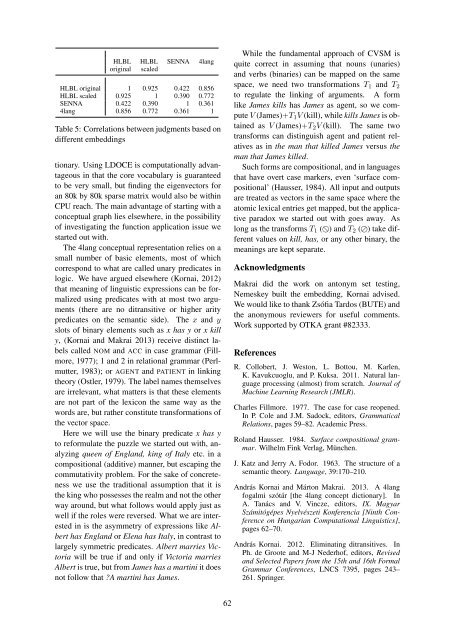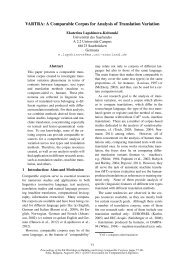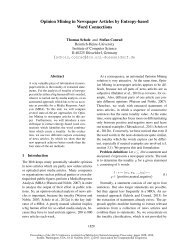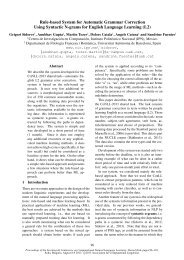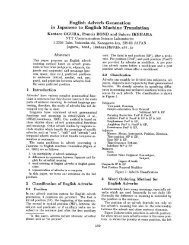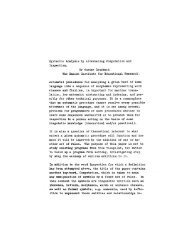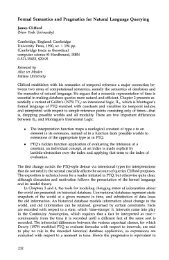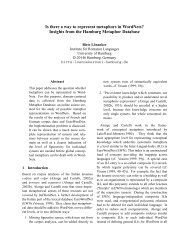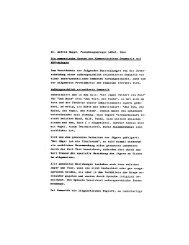Vector Space Semantic Parsing: A Framework for Compositional ...
Vector Space Semantic Parsing: A Framework for Compositional ...
Vector Space Semantic Parsing: A Framework for Compositional ...
You also want an ePaper? Increase the reach of your titles
YUMPU automatically turns print PDFs into web optimized ePapers that Google loves.
HLBL HLBL SENNA 4lang<br />
original scaled<br />
HLBL original 1 0.925 0.422 0.856<br />
HLBL scaled 0.925 1 0.390 0.772<br />
SENNA 0.422 0.390 1 0.361<br />
4lang 0.856 0.772 0.361 1<br />
Table 5: Correlations between judgments based on<br />
different embeddings<br />
tionary. Using LDOCE is computationally advantageous<br />
in that the core vocabulary is guaranteed<br />
to be very small, but finding the eigenvectors <strong>for</strong><br />
an 80k by 80k sparse matrix would also be within<br />
CPU reach. The main advantage of starting with a<br />
conceptual graph lies elsewhere, in the possibility<br />
of investigating the function application issue we<br />
started out with.<br />
The 4lang conceptual representation relies on a<br />
small number of basic elements, most of which<br />
correspond to what are called unary predicates in<br />
logic. We have argued elsewhere (Kornai, 2012)<br />
that meaning of linguistic expressions can be <strong>for</strong>malized<br />
using predicates with at most two arguments<br />
(there are no ditransitive or higher arity<br />
predicates on the semantic side). The x and y<br />
slots of binary elements such as x has y or x kill<br />
y, (Kornai and Makrai 2013) receive distinct labels<br />
called NOM and ACC in case grammar (Fillmore,<br />
1977); 1 and 2 in relational grammar (Perlmutter,<br />
1983); or AGENT and PATIENT in linking<br />
theory (Ostler, 1979). The label names themselves<br />
are irrelevant, what matters is that these elements<br />
are not part of the lexicon the same way as the<br />
words are, but rather constitute trans<strong>for</strong>mations of<br />
the vector space.<br />
Here we will use the binary predicate x has y<br />
to re<strong>for</strong>mulate the puzzle we started out with, analyzing<br />
queen of England, king of Italy etc. in a<br />
compositional (additive) manner, but escaping the<br />
commutativity problem. For the sake of concreteness<br />
we use the traditional assumption that it is<br />
the king who possesses the realm and not the other<br />
way around, but what follows would apply just as<br />
well if the roles were reversed. What we are interested<br />
in is the asymmetry of expressions like Albert<br />
has England or Elena has Italy, in contrast to<br />
largely symmetric predicates. Albert marries Victoria<br />
will be true if and only if Victoria marries<br />
Albert is true, but from James has a martini it does<br />
not follow that ?A martini has James.<br />
While the fundamental approach of CVSM is<br />
quite correct in assuming that nouns (unaries)<br />
and verbs (binaries) can be mapped on the same<br />
space, we need two trans<strong>for</strong>mations T 1 and T 2<br />
to regulate the linking of arguments. A <strong>for</strong>m<br />
like James kills has James as agent, so we compute<br />
V (James)`T 1 V (kill), while kills James is obtained<br />
as V (James)`T 2 V (kill). The same two<br />
trans<strong>for</strong>ms can distinguish agent and patient relatives<br />
as in the man that killed James versus the<br />
man that James killed.<br />
Such <strong>for</strong>ms are compositional, and in languages<br />
that have overt case markers, even ‘surface compositional’<br />
(Hausser, 1984). All input and outputs<br />
are treated as vectors in the same space where the<br />
atomic lexical entries get mapped, but the applicative<br />
paradox we started out with goes away. As<br />
long as the trans<strong>for</strong>ms T 1 (n) and T 2 (m) take different<br />
values on kill, has, or any other binary, the<br />
meanings are kept separate.<br />
Acknowledgments<br />
Makrai did the work on antonym set testing,<br />
Nemeskey built the embedding, Kornai advised.<br />
We would like to thank Zsófia Tardos (BUTE) and<br />
the anonymous reviewers <strong>for</strong> useful comments.<br />
Work supported by OTKA grant #82333.<br />
References<br />
R. Collobert, J. Weston, L. Bottou, M. Karlen,<br />
K. Kavukcuoglu, and P. Kuksa. 2011. Natural language<br />
processing (almost) from scratch. Journal of<br />
Machine Learning Research (JMLR).<br />
Charles Fillmore. 1977. The case <strong>for</strong> case reopened.<br />
In P. Cole and J.M. Sadock, editors, Grammatical<br />
Relations, pages 59–82. Academic Press.<br />
Roland Hausser. 1984. Surface compositional grammar.<br />
Wilhelm Fink Verlag, München.<br />
J. Katz and Jerry A. Fodor. 1963. The structure of a<br />
semantic theory. Language, 39:170–210.<br />
András Kornai and Márton Makrai. 2013. A 4lang<br />
fogalmi szótár [the 4lang concept dictionary]. In<br />
A. Tanács and V. Vincze, editors, IX. Magyar<br />
Számitógépes Nyelvészeti Konferencia [Ninth Conference<br />
on Hungarian Computational Linguistics],<br />
pages 62–70.<br />
András Kornai. 2012. Eliminating ditransitives. In<br />
Ph. de Groote and M-J Nederhof, editors, Revised<br />
and Selected Papers from the 15th and 16th Formal<br />
Grammar Conferences, LNCS 7395, pages 243–<br />
261. Springer.<br />
62


